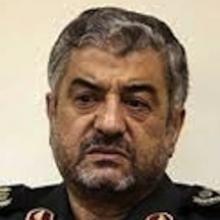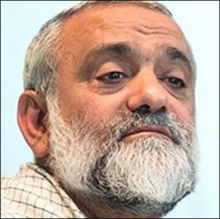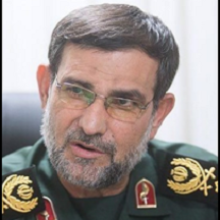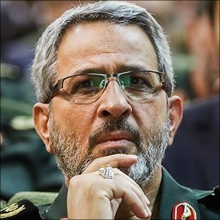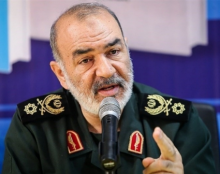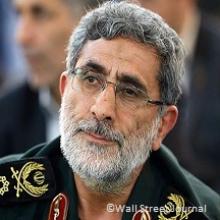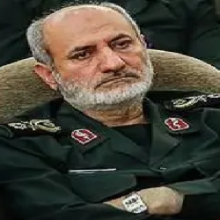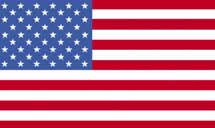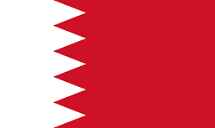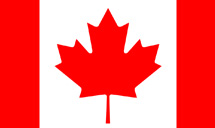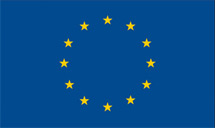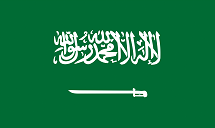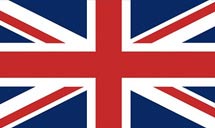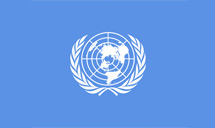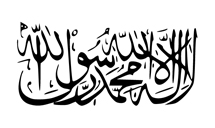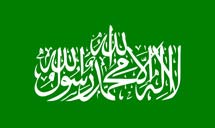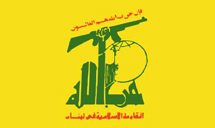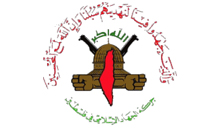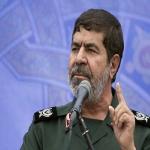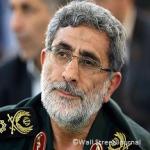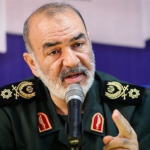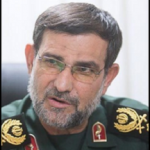Executive Summary:
The Islamic Revolutionary Guard Corps (IRGC) is tasked with preserving the Islamic Republic of Iran and the ideals of the 1979 revolution. The IRGC combines traditional military roles with a relentless focus on supposed domestic enemies. The IRGC is Iran’s primary instrument for exporting the ideology of the Islamic Revolution worldwide. It is rigidly loyal to Iran’s clerical elite. The IRGC is Iran’s main link to its terrorist proxies, which the regime uses to boost Iran’s global influence.
Within the IRGC are the Basij militia and the Quds Force (IRGC-QF). The Basij, literally “mobilization,” is a paramilitary organization charged with channeling popular support for the Iranian regime. The Basij is famous for its recruitment of volunteers, many of them teenage children, for human wave attacks during the Iran-Iraq war. Today, the Basij has two missions: to provide defensive military training to protect the regime against foreign invasion, and to suppress domestic anti-regime activity through street violence and intimidation. After the contested 2009 Iranian presidential elections, for example, the Basij brutally quashed protests and attacked student dormitories.
The IRGC’s Quds Force specializes in foreign missions, providing training, funding and weapons to extremist groups, including Iraqi insurgents, Hezbollah, and Hamas. The Quds Force allegedly participated in the 1994 suicide bombing of an Argentine Jewish community center, killing more than 80 and wounding about 300. In the years since, the Quds Force has armed anti-government militants in Bahrain, and assisted in a 2011 assassination attempt on Saudi Arabia’s ambassador to the United States. The Quds Force also plays a key role in support of Syrian regime forces in that country’s civil war.
Domestically, the IRGC exerts political and economic control throughout Iran. In April 2021, Iranian Foreign Minister Javad Zarif complained in an interview the IRGC had more influence in foreign affairs and the country’s nuclear dossier than him. Zarif alleged he had “zero” influence over Iran’s foreign policy and had “never been able to tell a military commander to do something in order to aid diplomacy.” Through a network of linked front companies, the IRGC has also created a dominant stake in Iran’s economic sector while exerting control over strategic industries to ensure loyalty to the supreme leader.
Doctrine:
The IRGC is an Iranian government agency tasked with defending the regime against internal and external threats. Espousing a radical ideology and a paranoid worldview, the IRGC uses secret police methods against its opponents within Iran, and terrorist tactics against its enemies abroad.
Iranian law defines the IRGC as “an institution commanded by the Supreme Leader whose purpose is to protect the Islamic Revolution of Iran and its accomplishments, while striving continuously . . . to spread the sovereignty of God’s law.”
In the first months after the 1979 Iranian revolution, before its existence was enshrined in law, the IRGC operated as a network of militant activists loyal to revolutionary leader Ruhollah Khomeini. In this role, the IRGC helped to stamp out dissident currents within the revolutionary movement. The IRGC views its task as preserving the “Islamic republican” form of government created by Khomeini, and faithfully implementing the instructions of Supreme Leader Ali Khamenei, who succeeded Khomeini after the latter’s death in 1989. Ahead of Iran’s June 2013 presidential elections, IRGC commanders reportedly made clear through public statements that they would only confirm a president who is loyal to Khamenei.
The IRGC today enjoys the power of a government agency, while still maintaining the zeal and fanaticism of an ideologically motivated terrorist group. The IRGC’s mission combines traditional military roles with a relentless focus on pursuing supposed domestic enemies. According to the Ministry of Defense, the IRGC’s role is to “protect [Iran’s] independence, territorial integrity, and national and revolutionary ideals, under the shadow of the orders given by the Commander in Chief, the Grand Ayatollah Imam Khamenei.” Political beliefs considered inconsistent with “revolutionary ideals” are treated as military threats. Then-IRGC commander Jafari stated in 2014: “today’s war is not fought on land or sea, it is fought at the level of belief, and the enemy is investing efforts to gain influence inside the Islamic Republican system.”
The IRGC’s doctrine combines rigid loyalty to Iran’s clerical elite with deep paranoia about the outside world. In IRGC publications, Iran is portrayed as threatened by American and “Zionist” plots, which are said to be capable of exerting great influence within Iran. Allegations of foreign meddling in Iran provide the justification for terrorism abroad, fueling the high-profile international conflicts that provide the basis for ever harsher crackdowns on internal dissent. The IRGC considers “resistance” to Israel and support for so-called resistance groups among its primary regional goals. IRGC propaganda refers to Israel as a conspiracy against the region backed by the United States and the United Kingdom. Through its support for Hezbollah, Hamas, and other terror groups, the IRGC leads what it calls a regional axis of resistance to “speed up the downfall” of Israel and “the liberation of al-Quds,” the Arabic name for Jerusalem. The IRGC provides military and strategic aid to its regional proxies. In 2016, for example, the IRGC provided Hezbollah with kits to convert short-range rockets into longer-range missiles, capable of hitting strategic targets inside Israel.
Over time, domestic repression has come to overshadow traditional military missions, as the IRGC’s influence has spread into every aspect of Iranian life. In 2007, following the formal incorporation of the Basij militia into the IRGC, IRGC Commander Mohammad Ali Jafari said, “The new strategic guidelines of the IRGC have been changed by the directives of the Leader of the Revolution [i.e., Supreme Leader Ali Khamenei]. The main mission of the IRGC from now on is to deal with the threats from the internal enemies. [The number-two priority of the corps] is to help the military in case of foreign threats.”
The IRGC considers its loyalty to Supreme Leader Ali Khamenei a religious imperative. At times, the organization’s devotion to Khamenei slips into hero-worship. In 2014, for example, deputy IRGC commander Mohammad Hejazi credited Khamenei with overruling the objections of scientific experts to direct research towards increased accuracy in ballistic missiles, “resulting in proud accomplishments in this field.”
Organizational Structure:
Islamic Revolutionary Guard Corps
By law, the power to appoint and remove the commander of the IRGC is given to the supreme leader. The supreme leader also appoints clerical representatives to the various units of the IRGC whose guidance and instructions are binding on commanders. Iranian law makes “belief and practical obedience to the principle of clerical rule” a condition of membership in the IRGC, further establishing absolute loyalty to Supreme Leader Ali Khamenei as the IRGC’s guiding principle.
Efforts to normalize the IRGC’s extraordinary role in Iran over the years have resulted in a complex organization chart. Administratively, the IRGC falls under the Joint Armed Forces General Staff, part of the Ministry of Defense. But these layers of oversight do not give Iran’s nominally elected civilian authorities real control over the IRGC, as the entire military remains subordinate to the Supreme National Security Council, which in turn answers to Supreme Leader Ali Khamenei.
Scholars who study the IRGC have concluded that “individuals appear to matter more than institutions when considering national security decision[-]making.” Consequently, scholars have identified personal networks, often based on ties of family, friendship, or joint service in the 1980-1988 Iran-Iraq War as the key factors in IRGC leadership. The opacity of the IRGC’s real command structure helps make Iran an erratic and therefore especially dangerous player in regional affairs.
Formed in 2009 on the order of Iranian Supreme Leader Ali Khamenei, the IRGC Intelligence Organization (IRGC-IO) is a domestic and international unit that targets journalists, activists, dual Iranian nationals, and others who oppose the abuses and human rights violations perpetrated by the Iranian regime. The IRGC-IO operates independently and reportedly serves as an ideological counterweight to Iran’s Ministry of Intelligence (MOIS), as it is under direct control of the supreme leader while MOIS is under the control of the Iranian president. After Mohammad Kazemi replaced Hossein Ta’eb as head of the IRGC-IO in June 2022, media reports indicated other Iranian security agencies had sought to limit the IRGC-IO’s power. With the spread of anti-regime protests in Iran in the fall of 2022, the IRGC-IO and MOIS accused foreign intelligence agencies of instigating and financing the protests. The United States sanctioned the IRGC-IO on April 27, 2023, for its role in the hostage-taking or wrongful detention of U.S. nationals in Iran. According to the U.S. Department of State, the IRGC-IO has been involved in the wrongful detention of at least one U.S. national abroad.
Basij
The Basij militia, whose name means “mobilization,” is a paramilitary organization tasked with channeling popular support for the Islamic Republican regime. The Basij was created on April 30, 1980, to assist the IRGC in maintaining order. The Basij is most famous for its recruitment of volunteers, many of them teenage children, for human wave attacks on Iraqi forces during the Iran-Iraq War in which thousands died. Following the Iran-Iraq War, the Basij assumed a police role in Iran to maintain loyalty to the regime and suppress protests. Today, the Basij has two missions: giving military training to regime supporters to prepare them to resist foreign invasion, and helping suppress domestic opposition to the regime through street violence and intimidation. According to the 1980 Iranian law that created the Basij, the militia’s purpose is “to train and organize all volunteers for encountering any threat and invasion against the accomplishments of the Islamic revolution from inside and outside.”
The Basij presents itself as a popular volunteer association, although it is very much an organ of the state. The group’s “regular members,” said to number more than ten million, are unpaid volunteers motivated by ideological zeal or the hopes of advancement. Its “active members” receive salaries and work full time to organize the volunteer members. According to U.S. government estimates, the Basij comprise 100,000 active members, while hundreds of thousands of volunteers could be mobilized in war. The group has been nominally subordinate to the IRGC since the early 1980s, and organizational changes in recent years have increased the IRGC’s direct control over the Basij, apparently to better manage the two groups’ repression of internal dissent. The Basij were formally incorporated into the IRGC in July 2008 and report directly to the IRGC commander-in-chief.
Khatam al-Anbia
Created in 1989, Iran’s Khatam al-Anbia (KAA) is an IRGC-controlled engineering firm that acts as the organization’s construction arm. KAA maintains more than 800 subsidiaries, collectively employing more than 40,000 people. Approximately 70 percent of the firm’s business is believed to be military-related. KAA has played a role in building Iran’s nuclear infrastructure, including the country’s nuclear facilities at Qom and Fordow.
The company has won more than 17,000 no-bid contracts from the government. For example, in December 2012, KAA was reportedly set to begin construction of the “world’s tallest dam” in Iran after the government canceled a $2 billion contract with a Chinese firm and turned the project over to the IRGC. According to United Against Nuclear Iran, “Through Khatam al-Anbia, the IRGC has succeeded in assuming a dominant role in Iran’s oil and gas industry.” Khatam al-Anbia has become one of Iran’s largest contractors in industrial and development projects. In February 2022, the Iranian parliament’s Budget Reconciliation Committee announced a deal with Khatam al-Anbia to complete unfinished prayer houses in exchange for more than $477 million in crude oil.
Quds Force
The Quds Force (IRGC-QF) is a special branch of the IRGC tasked with achieving sensitive missions beyond Iran’s borders. The IRGC-QF has played an active role in providing training and weapons to extremist groups including Iraqi insurgents, Lebanese Hezbollah, and others. The group’s commander is Brigadier General Ismail Ghaani, who was appointed to the role after the January 3, 2020, assassination of the group’s longtime leader, Major General Qasem Soleimani. In addition to overseeing the group’s violent attacks, Soleimani served as an emissary of Supreme Leader Ali Khamenei, reportedly using a combination of violence and bribes to wield enormous influence over the politics of neighboring Iraq. He was also said to coordinate much of Iran’s support for the Ba’ath regime in the Syrian civil war.
General Hossein Hamedani, deputy commander of an IRGC volunteer unit, told an Iranian news agency in 2008 that the IRGC is providing weapons to “liberation armies” in the Middle East, including groups in Lebanon and Iraq. Such liaisons are the responsibility of the IRGC-QF.
Since Ghaani took control of the Quds Force, however, there have been numerous reports that he has been unable to exert the same influence over Iran’s terrorist proxies. According to media sources, Ghaani allegedly does not have the same expertise as his predecessor and does not have a rapport with Khamenei or his office—a critical element of his role as commander of the Quds Force. These allegations were exacerbated following a November 7, 2021, drone attack on the Baghdad home of Iraqi Prime Minister Mustafa al-Kadhimi. Suspicions fell on Iran-backed militias, particularly Asaib Ahl al-Haq (AAH) and Kata’ib Hezbollah (KH). The militias and Iran denied involvement in the attack, which lightly wounded Kadhimi and wounded seven members of his security detail. Ghaani visited Baghdad on November 8 and denied Tehran had any connection to the attack. Following the attack, reports emerged of fractures between Iran and its proxies. AAH and KH have reportedly openly defied orders from Ghaani. AAH commander Qais al-Khazali and KH commander Abu Hussein al-Hamidawi allegedly told the Iranians that Tehran’s support for Kadhimi receiving a second term in Iraq’s October 2021 elections broke the allies’ bond. Some security analysts in Iraq alleged Ghaani had lost control over the Iraqi militias. On February 3, 2022, U.S. General Frank McKenzie, head of U.S. Central Command, declared Ghaani “does not exercise the same degree of control over Iranian-aligned militia groups” as Soleimani did. As a result, other branches of the IRGC have reportedly taken a larger role in coordinating with Iran’s proxies.
Training and Recruitment:
General
The IRGC is the third-wealthiest organization in Iran after the National Iranian Oil Company and the Imam Reza Endowment. Due to its vast wealth, the IRGC is able to use a very simple recruitment tactic: money. The IRGC attracts young men by paying them up to $265 a month. In 1982, the IRGC created its first high school in Tehran to train and indoctrinate young men into the organization. The IRGC opened similar schools throughout the country. Graduates went on to join the IRGC and Basij. The program ended and the schools closed in 1999, but the IRGC announced plans in early 2015 to reopen affiliated high schools.
The Basij and Quds Force operate under the IRGC and are responsible for the bulk of the umbrella organization’s recruitment. Both groups have developed an organized method of enrollment and training. Both the Basij and the Quds Force strategically place recruiters near holy sites, mosques, schools, and community centers to attract volunteers. The IRGC also trains foreign fighters from groups like Hezbollah and Hamas.
Basij
Training
The Basij is a paramilitary organization operating under the IRGC that relies heavily on volunteers as well as paid members. The Basij constitution highlights the importance of training, stating that one of the force’s most important responsibilities is to train volunteers to “defend the country and the Islamic Republic regime.” The Basij is increasingly being used to quell internal unrest in Iran and, consequently, has become highly organized.
The Basij has an extensive membership of regular, active, and special recruits. Each classification is based on the volunteer’s level of training and, to a lesser degree, on his level of commitment.
The Basij relies heavily on Ideological-Political Trainers (IPTs) to indoctrinate and educate its fledgling members. IPTs are divided into three groups: organizational, non-organizational, and invited members. Organizational and non-organizational IPTs typically hold high school degrees, while invited trainers are usually well-connected and well-educated. Trainees are also required to attend at least 18 hours of ideological and political courses on subjects like “Major Islamic Commandments.”
The next level of training consists of courses that include “Jihad and Defense of the Quran,” and “Fluency in Reading the Quran.” Specialized training courses in areas such as advanced psychological warfare and anti-riot training last even longer but are not mandatory. Only after completing this final level of training can Basij members go to mosques, schools, and factories to organize. Basic Basij members are also trained in practical matters such as weaponry, guard duty, civil defense, and first aid.
IPTs are themselves educated by a network of political guides. IPTs are taught subjects like Islamic commandments, the Quran, the history of Islam, sociopolitical knowledge, and the fundamentals of belief.
Recruitment
Basij recruitment relies heavily on the cooperation of local and regional mosques. Members are recruited under “clergical [sic] supervision and trusted citizens.” Paid Basij positions are available by application at Basij central offices.
The Basij also target Iranian schools for recruitment. The Iranian parliament passed a 1996 law authorizing the government to create children’s Basij units. The Basij expanded their recruitment activities in Iranian schools after the disputed 2009 presidential elections, when Basij militants helped to violently suppress protests. In November 2009, the Basij established 6,000 “resistance centers” in the nation’s elementary schools to promote the ideals of the Iranian Revolution. By 2010, the so-called Student Basij included 4.6 million members. These students were divided into units based on age: Omidan (“Hopes”) in elementary schools, Pouyandegan (“Seekers”) in middle schools, and Pushgaman (“Standard Bearers”) in high schools.
Quds Force
Training
The Quds Force is a special unit of the Revolutionary Guard that oversees weapons and training. Basic training can last anywhere from three to nine months and takes place at three main facilities in Iran. The first is the Imam Ali Base near Tehran, which specializes in ground training for foreign fighters. The second is the Wali-e-Assar Base in Shiraz and the third is the “Jerusalem Operation” College in Qom, where trainees study spirituality and ideology. There are other smaller training facilities throughout the country that are used to train armed groups from foreign countries as well. The Quds Force helps operate the Manzariyah training center in Iran near the holy city of Qom. The Manzariyah training center recruits from a pool of foreign students studying at a nearby religious seminary.
Recruitment
The Quds Force sets up recruitment offices near Islamic holy sites to attract a wide variety of devout people from many nationalities throughout the Muslim world, including Saudi Arabia, Syria, and Iraq. The most important recruitment office is in the “Dar al-Tawahid” hotel in Mecca, Saudi Arabia. The Quds force helps operate the Manzariyah training center in Iran near the holy city of Qom. The Manzariyah training center recruits from a pool of foreign students studying at a nearby religious seminary. The Quds Force also recruits in Iraq, where they reportedly paid Iraqi Shiites up to $150 per month to go to Iran to train during the anti-U.S. insurgency.
Financing:
IRGC
The Trump administration claimed that it forced the Iranian regime to reduce its military spending by 30 percent since the administration began re-imposing financial sanctions in 2017. Iranian officials have dismissed the effectiveness of renewed sanctions. Iran’s defense budget ranges from approximately $10 billion to $15 billion annually. Of that, the IRGC receives approximately two-thirds. Shortly after the death of Quds Force commander Qasem Soleimani in a U.S. airstrike in January 2020, the Iranian government increased its budget for the Quds Force by more than €200 million over the following two months. The funding increase was part of a bill called “Counter-Measures Against U.S.,” which Iran’s parliament approved by a vote of 229-3. Iran’s 2021 budget provided the IRGC with an allocation of 403 trillion rials, almost double the 212.79 trillion rials allocated toward Iran’s conventional military. On December 12, 2021, Iranian President Ebrahim Raisi submitted a proposed 2022 budget to parliament that more than doubled the IRGC’s government allocation to 930 trillion rials (U.S. $22 billion).
Iran has consistently increased its budget allocations to the IRGC in recent years. The IRGC received a reported 24 percent increase in Iran’s proposed 2017-18 fiscal budget, up from $4.5 billion to $7.4 billion. The IRGC’s allocation represented 53 percent of Iran’s defense budget. Iran’s military budget has reportedly experienced a 70 percent increase in funding during President Hassan Rouhani’s tenure, growing from $3.3 billion in FY 2013-14 to more than $5 billion after Rouhani assumed the presidency in 2013. Ahead of the FY 2016 budget, however, Rouhani reportedly sought to cut the IRGC’s budget in favor of Iran’s army. The Iranian parliament rejected the cut and raised the IRGC’s budgetary allocation. Rouhani reportedly cut the IRGC’s budget by 17 percent in his proposed 2019-2020 budget submitted in December 2018. In 2020 alone, the IRGC budget reached $6.96 billion, triple the total budget of Iran’s army and approximately 20 times more than the budget for Iran’s defense department. In December 2020, the proposed budget for 2021-2022 reportedly included a 65 percent increase for the IRGC.
Despite the increases, in June 2021 Iranian President Hasan Rouhani cut the IRGC’s funding for missile production by about 50 percent and also cut funding to the Quds Force, leading IRGC commander Hossein Salami and Quds Force commander Ismail Ghaani to file a complaint with Supreme Leader Ali Khamenei. Salami reportedly asked Khameini to use his own cash budget to transfer the funds needed by the Quds Force to pay the salaries of its fighters and to intervene and force the government to stop its alleged hostile actions. At the same time as the alleged budget cuts, reports emerged of Qatari financial support for the IRGC. In late June 2021, outgoing Israeli President Reuven Rivlin delivered intelligence to the White House of the Qatari support. In July 2021, the U.S. State Department opened an investigation into the allegations.
The IRGC is also Iran’s most powerful economic actor, according to the U.S. Treasury Department, which labeled the National Iranian Oil Company “an agent or affiliate of the Revolutionary Guards.” According to a 2017 assessment by then-CIA Director Mike Pompeo, IRGC-linked companies control up to 20 percent of Iran’s economy. In July 2018, the city council of Tehran announced that the IRGC Cooperative Foundation, which manages the IRGC’s investments, had embezzled more than $1 billion from the city of Tehran.
Within the IRGC, the Quds Force exerts control over strategic industries, commercial services, and black-market enterprises. According to a 2007 Los Angeles Times report, the IRGC has ties to over 100 companies, controlling over $12 billion. These funds are used to exert influence in Iran and Iranian proxies. According to Ray Takeyh of the Council on Foreign Relations, the IRGC is “heavily involved in everything from pharmaceuticals to telecommunications and pipelines – even the new Imam Khomeini Airport and a great deal of smuggling. Many of the front companies engaged in procuring nuclear technology are owned and run by the Revolutionary Guards. They're developing along the lines of the Chinese military, which is involved in many business enterprises. It's a huge business conglomeration.”
After the 2015 nuclear agreement—which opened Iran’s economy to the international market, Iranian President Hassan Rouhani’s government attempted to restrict the IRGC’s economic power in Iran, open Iran’s economy internationally, and attract foreign investors by canceling government contracts with IRGC subsidiaries. An unidentified IRGC source told Reuters in November 2016 that any U.S. attempt to restrict the Iranian economy from global markets would result in the IRGC regaining its economic control of Iran. In March 2016, Khamenei called for the IRGC to play a larger role in creating a “resistance economy” in Iran, independent of the international community.
In August 2015, Reuters reported that the IRGC stood to benefit from the lifting of economic sanctions against Iran as part of the P5+1 nuclear deal. One beneficiary Reuters highlighted is IRGC conglomerate KAA, which reportedly controls at least 812 affiliated companies worth billions of dollars. KAA subsidiary companies have been sanctioned by the United States, the European Union, and the United Nations as “proliferators of weapons of mass destruction,” according to the U.S. government. The IRGC reportedly controlled one-third of Iran’s economy as of 2010. As of November 2016, the group viewed the possibility of renewed sanctions against Iran and the threat posed by ISIS as pathways to limiting foreign investment in Iran and reestablishing IRGC control of the economy.
In addition to its roles in Iran’s other economic sectors, the IRGC also profits from Iran’s oil industry. On October 26, 2020, the U.S. government sanctioned the Iranian Ministry of Petroleum, the National Iranian Oil Company, and the National Iranian Tanker Company for their financial support to the Quds Force. U.S. Treasury Secretary Steven Mnuchin accused Iran of using “the petroleum sector to fund the destabilizing activities of the IRGC-QF.”
In October 2017, the U.S. government designated the IRGC as a terrorist organization and levied financial sanctions against it for the IRGC’s support of the Quds Force, as well as Hamas, Hezbollah, and the Taliban. In March 2018, members of the U.S. House of Representatives Foreign Affairs Committee began discussing additional sanctions on entities in which the IRGC has a 50-percent-or-less ownership stake in order to punish IRGC front companies. The U.S. government designated the IRGC as a foreign terrorist organization in April 2019, opening the possibility of levying additional sanctions on IRGC-related businesses. According to U.S. Treasury Secretary Steven T. Mnuchin, “Iran employs a web of front companies to fund terrorist groups across the region, siphoning resources away from the Iranian people and prioritizing terrorist proxies over the basic needs of its people.”
The United States has since sanction-designated multiple Iranian businesses and their leaders for ties to the IRGC. In October 2019, the U.S.-led Terrorist Financing Targeting Center (TFTC) jointly designated 25 targets accused of supporting the IRGC and Hezbollah. Included in the sanctions were 21 businesses accused of providing financial support to the IRGC’s Basij militia. The TFTC includes Bahrain, Kuwait, Oman, Qatar, Saudi Arabia, the United Arab Emirates, and the United States. In March 2020, the U.S. government sanctioned 20 companies based in Iran and Iraq linked to the IRGC. In May 2020, the Treasury Department sanctioned Iranian-Iraqi national Amir Dianat and his Taif Mining Services LLC company for involvement in the shipment of missiles on behalf of the IRGC-Quds Force and smuggling “lethal aid” from Iran to Yemen.
Iran also utilizes multiple front companies in and around the Middle East to facilitate the flow of money to the IRGC, which then provides financing to Iran’s terror proxies. In 2018, for example, the U.S. government imposed sanctions on two individuals—Muhammad Qasim al-Bazzal and Ali Qasir—accused of heading international front companies that finance transactions between Hezbollah and the IRGC. Bazzal is co-founder of the Syria-based Talaqi Group and a key financier for Hezbollah and the IRGC-Quds Force. Qasir is the managing director of the Talaqi Group. Since 2018, Bazzal has used the Talaqi Group and his other companies to facilitate illicit oil shipments for the Quds Force.
The U.S. Department of the Treasury’s Office of Foreign Assets Control (OFAC) accuses the IRGC of using the Central Bank of Syria to coordinate financial transfers with Hezbollah. According to OFAC, Iran has created an international network working with Russian companies to provide millions of barrels of oil to the Syrian government. Syria then facilitates the movement of hundreds of millions of U.S. dollars to the IRGC, which distributes the money to Hezbollah and Hamas. U.S.-designated Hezbollah official Muhammad Qasir heads the Hezbollah unit responsible for facilitating the transfer of weapons, technology, and other support from Syria to Lebanon. According to the U.S. State Department, Qasir is a “critical link” between Iran and Hezbollah.
On August 13, 2021, OFAC imposed sanctions on Omani national Mahmood Rashid Amur Al Habsi and a network of his businesses. According to OFAC, Al Habsi’s Oman-based company, Nimr International L.L.C., facilitated the sale and shipment of Iranian oil in support of the Quds Force. OFAC also designated Oman-based Orbit Petrochemicals Trading LLC, which it accused Al Habsi of using to facilitate Iranian oil deals that obscured the Quds Force’s involvement. OFAC also designated Liberian-registered Bravery Maritime Corporation and Romania-based Nimr International S.R.L. for being owned, controlled, or directed by Al Habsi.
The Iranian government has also sought to directly expand the IRGC’s control over Iran’s economy. In January 2022, Iran’s energy ministry announced a 300-billion-rial contract with the IRGC’s Imam Hasan Headquarters for water projects in rural areas. Also, that month, the Iranian government reportedly awarded a $3 billion rice farming project to the IRGC’s Khatam al-Anbia engineering firm, which would make Iran independent of the rice import market. Khatam al-Anbia denied the report, but it remains one of Iran’s largest contractors in industrial and development projects. In February 2022, the Iranian parliament’s Budget Reconciliation Committee announced a deal with Khatam al-Anbia to complete unfinished prayer houses in exchange for more than $477 million in crude oil.
Basij
The Basij received a budget of $310.85 million in the 2015 fiscal year. In the 2009-2010 budget, the Basij received $430 million from the government, but also reportedly earned large sums of cash through its control of non-profit foundations created by the Basij and IRGC in the 1980s and 1990s. The Basij is also reportedly a major investor in the Tehran stock exchange.
Also Known As:
- Islamic Revolutionary Guards
- Pasdaran (“Guards”)
- Revolutionary Guards
- Sepah (“Corps”)
- Sepah-e Pasdaran-e Enghelab-e Eslami (“Islamic Revolutionary Guard Corps”)

